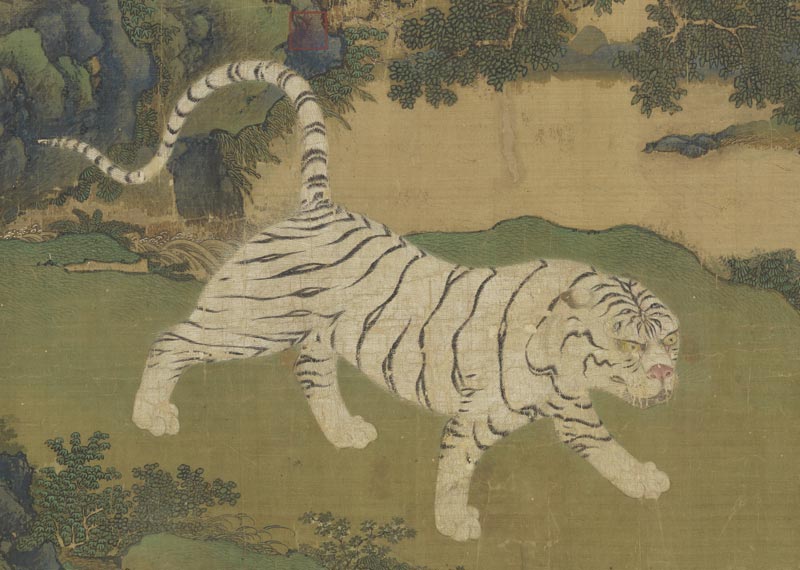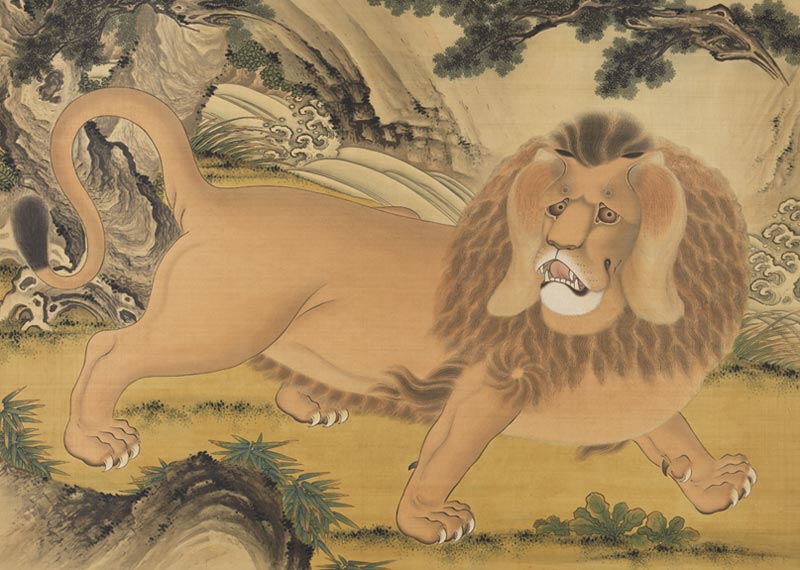Precious Birds and Strange Beasts
Transportation in the old days was not nearly as convenient as it is now. People had really little chance to see animals from faraway places. In addition to being prized as exotic animals, they were often viewed in the same way as beasts of myth. For example, everyone knows what a giraffe is, but more than 600 years ago, it was mistakenly thought to be the auspicious animal of legend known as a qilin (kirin in Japanese). Even today, in Japanese and Korean, the word for giraffe still goes by the name of this legendary beast. When ancient painters depicted rare animals, it did not necessarily mean they had a chance to see the creatures in person. As a result, they would often add elements from their own imagination, which is why there is sometimes a great difference between the paintings and what we see in reality.
-
 Tiger of the Inner CourtAnonymous, Ming dynasty (1368-1644)
Tiger of the Inner CourtAnonymous, Ming dynasty (1368-1644)In the autumn of 1404, the second year of the Yongle reign, it was reported that a mythical animal known as a "zouyu" was spotted in the Shenhou Mountains in the realm of Zhu Su, Prince Ding of Zhou. Zhu Su thereupon led a squad to capture the beast. After catching the rare animal, it was presented as tribute to Chengzu, the Yongle emperor. This is a painting of the "zouyu" captured in the Shenhou Mountains. As it shows, the "zouyu" is actually a rare white tiger said to be able to predict good or bad luck. For this reason, the appearance of a "zouyu" was considered an auspicious omen indicating the presence of a ruler possessing the virtues of benevolence and faith.
-
 LionLiu Jiude (fl. ca. late 17th c.), Qing dynasty
LionLiu Jiude (fl. ca. late 17th c.), Qing dynastyLiu Jiude, a native of Shuntian (modern Beijing), specialized in painting figures but was especially gifted at depicting ladies and doing portraits.
The name of this paintings mentions the animal depicted as a "suanni," which is the ancient name for a lion in Chinese. In this very large work, a lion is seen walking by a fast-moving stream, the robust body of the animal taking up almost the entire composition to convey its fierce and majestic character. The lines of the brushwork here to depict the lion are exceptionally refined, the hairs of the mane rendered almost stroke by stroke for the individual strands. The background, on the other hand, has much more bravura, creating a dramatic contrast with the lion. However, since people in ancient times rarely had the chance to view a lion, they must have added numerous details of the imagination, as demonstrated by the odd and even humorous features seen here.